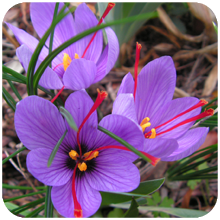
Crocus Sativus (Saffron) is herbaceous, perennial, cultivating plant, which can reach 30-40 cm in height. Its leaves are long and narrow. Its fruits are small and white. The flowers are violet with purple lines. Grows from the bulbs called `cormus` and belongs to the species crocus. From September to November, the plant produces purple-blue flowers with long red pistils. The leaves, which are similar to the grass, grow simultaneously when humidity is elevated, and after opening of the flower at the time of drought. Crocus sativus is a capricious plant. The red stigmas contain essential oils, bitter substances and yellow pigments.
Chemical composition – The active principles are carotenoids (protocrone, alpha, beta and gamma-carotene, lycopene, prolicopine, zeaxanthin) represented bitter picrocrocoside (glucoside 4-beta-hydroxy-cyclocitral), volatile oil. The main components of the essential oil are eucalyptol, cineol, pinene and safranalul.
Properties – Skin regenerating, antioxidant, anti-inflammatory, improves blood circulation, aphrodisiac, antidepressant, antispasmodic, stomachic, asthmatic, antitussive, tonic gastric and central nervous system.
Recommendation – Menstrual disorders, depression, cough, asthma, gout, fever, biliary and liver diseases, menstrual pain, dyspepsia, gastric atony, abdominal distension and flatulence. In hemorrhoidal diseases, bruising, conjunctivitis, phlegmons and toothache, burns and superficial wounds.
This plant is incorporated in natural remedy GOLD CREAM.




